Apple 27-inch LED Cinema Display Review
by Anand Lal Shimpi on September 28, 2010 12:15 AM EST- Posted in
- Displays
- Mac
- Apple
- Cinema Display
Brightness and Contrast
For brightness, black level, and contrast points, we use the same colorimeter setup described earlier. Specifically, we use an Xrite i1D2 with ColorEyes Display Pro, and take measurements at maximum and minimum brightness of white and black targets. Dynamic contrast is turned off. We also let the panels settle in for a half hour at the respective settings before taking any measurements.
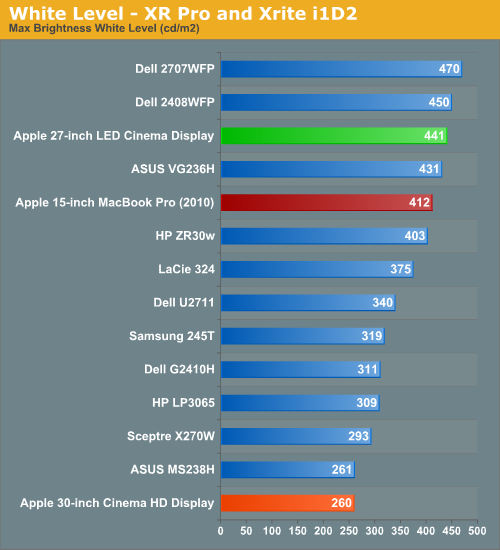
The new 27-inch LED Cinema Display is bright. It's within 10% of the 2707WFP and brighter than Dell's CCFL backlit U2711, which has a similar panel to what Apple uses in the 27-inch LED Cinema Display. If you're a fan of very bright displays, the 27-inch won't disappoint. I tossed in my 30-inch Cinema HD Display results as a reference point but keep in mind this is a very old unit (originally purchased in 2004) so it's not going to perform quite as good as it did while new.
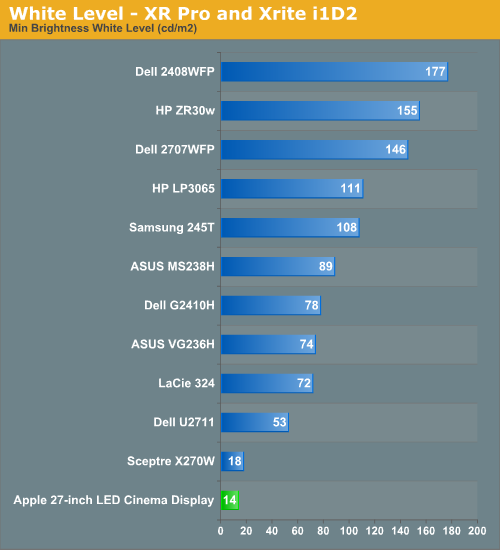
Drop brightness all the way and the 27-inch LED Cinema Display gets dim. There's a good amount of dynamic brightness range on this display, it's very flexible.
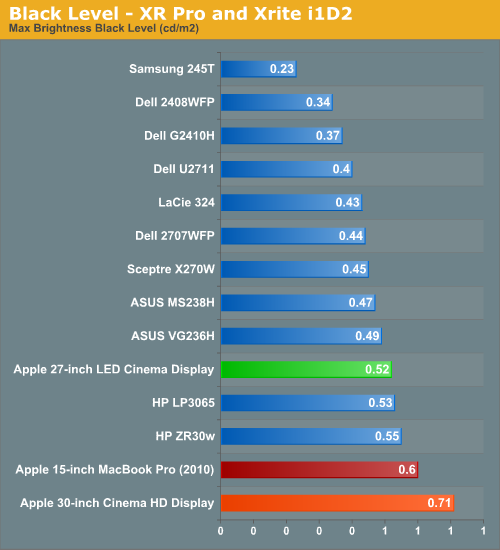
Absolute black levels are simply ok, not stellar for a high end display but not horrible either. It's clear Apple optimized for maximum brightness rather than deep blacks in order to compensate for the glossy front cover.
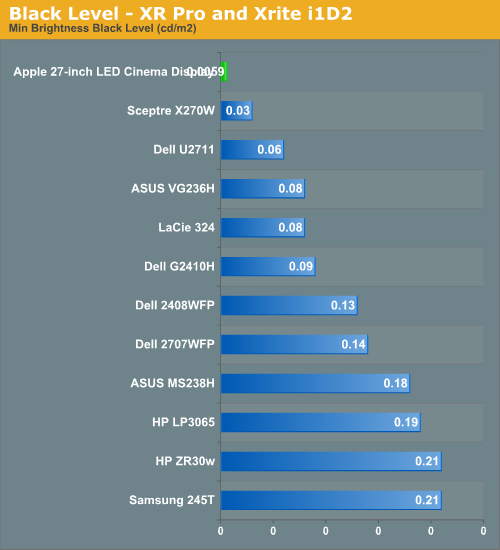
At the lowest measurable brightness setting the black levels are very low. You can actually get the display dark enough for my eyeOne D2 to register 0 nits. I had to bump brightness up a bit just to get the black level to register.
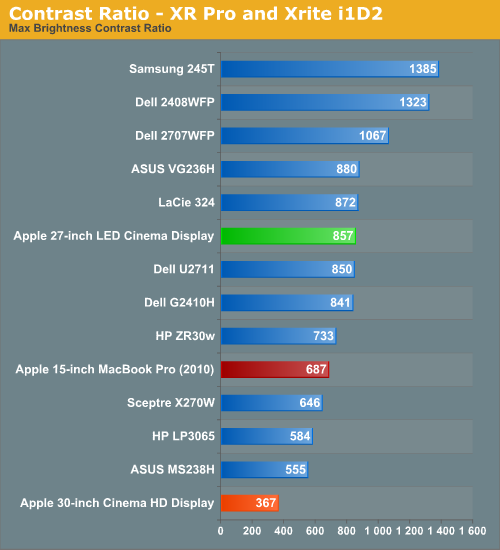
This isn't terrible but I would've liked to see something above 1000:1. Again it's sort of middle of the road for a high end display. Note that even at 200 nits the contrast ratio is 837:1, so unless you significantly reduce brightness you won't see a huge difference in contrast ratio.
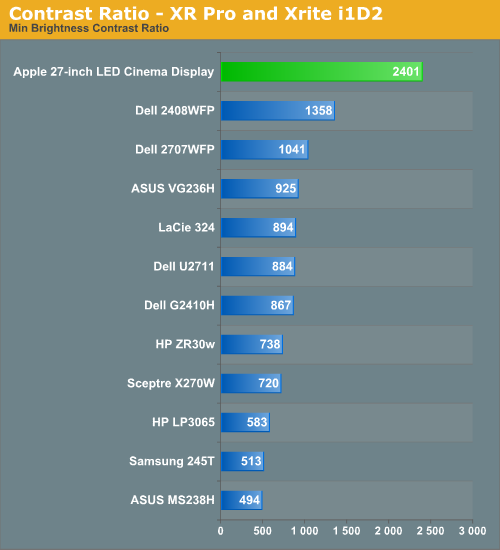
Thanks to very low black levels at the lowest brightness settings the contrast ratio skyrockets. As I mentioned before, at 200 nits the contrast ratio is still down at 837:1 so the numbers above aren't very real world unless you like using very dim displays. You can also count on the 27-inch display being quite usable at lower brightness settings as a result.










93 Comments
View All Comments
Valleyvalley - Wednesday, November 17, 2010 - link
I really don't understand why all the so-called professionally keep bashing glossy screens. I mistakenly bought a matte screen after reading such reviews and it is horrible. Because the black level is not great, and because the coating is not smooth, reading text is painful. I have to make the font size much larger than normal to be able to read clearly and smoothly, which essentially doesn't take advantage of the high resolution much. As a result I am returning it. If you go to the review section on Amazon about Dell U2711 you'll see similar complains. After this experience, I decide to go with the market choice instead of listening to any of the so-called professionals and I would never touch a matte screen again, althought I will not necessarily buy the Apple LED. Professionals would like to think that because they learned such and such, they can somehow tell people what looks better. However, in reality that is totally rubbish and it is still up to the consumers to decide what looks better and what products will succeed. Professionals also would like to think they are smart and people are idiots easily swayed by marketing strategies, and they are so enthusiastic to convince people something like "what looks better in your eyes". I would say marketing clearly playes a role but in the end most people are not idiots and they know what they are seeing and can compare the effects using their eyes.Glossy is not a joke. It has clear advantage of black and white levels, more vibrant colors, and there are even comparisons online of glossy and matte screens under sunlight, with the glossy screen reflective but still visible and vibrant, but the matte screen totally washed out. It is more of a debate and personal preference. If you google "glossy vs matte" you'll find that it is not so one-sided. There are many people who don't know what glossy is and what matte is and they just believe in their eyes, and there is nothing wrong with it and they are not idiots. At the end of the day it is what matters, right? How can you win people's eyes. Those numbers of color, constrast, etc. are meaningless to most people. A picture is worth a thousand words. People can use their own eyes to make a choice. Don't be too self-confident in telling people what to do. It is really not Apple who doesn't listen to its customers because Apple is a product, and needs to win customers and it is doing pretty well so far. It is the so-called professionals who simply don't like to change and they don't, and simply have no need to listen to Apple's customers because they don't make any products and they just like to do stuff the good old ways.
kenpmason - Thursday, May 12, 2011 - link
Your comments regarding matt vs glossy screens ignore a critical spec--dot pitch. The Dell U2711, which I've been using for a year now, has what I believe to be the smallest dot pitch available on the market today, 0.233. Most other screens have 0.250-0.300-- in other words, coarser. If you take a given rez and spread it over more real estate, then the dot pitch has to increase.People who "believe in their eyes" also tend to gravitate to screens with overly vivid (or lurid) colours. This can easily be seen when comparing low-end HDTVs to high-end ones. Similarly, glossy screens are more impressive at first glance, but over time they wear out their welcome.
Please comment!
richardbalboa - Monday, October 4, 2010 - link
In 35 years on this planet I cannot once remember ever going to the cinema to watch a film on a glossy screen.datajerk - Tuesday, November 9, 2010 - link
Any chance you'll post your tuned display profile?Valleyvalley - Wednesday, November 17, 2010 - link
I really don't understand why all the so-called professionally keep bashing glossy screens. I mistakenly bought a matte screen after reading such reviews and it is horrible. Because the black level is not great, and because the coating is not smooth, reading text is painful. I have to make the font size much larger than normal to be able to read clearly and smoothly, which essentially doesn't take advantage of the high resolution much. As a result I am returning it. If you go to the review section on Amazon about Dell U2711 you'll see similar complains. After this experience, I decide to go with the market choice instead of listening to any of the so-called professionals and I would never touch a matte screen again, althought I will not necessarily buy the Apple LED. Professionals would like to think that because they learned such and such, they can somehow tell people what looks better. However, in reality that is totally rubbish and it is still up to the consumers to decide what looks better and what products will succeed. Professionals also would like to think they are smart and people are idiots easily swayed by marketing strategies, and they are so enthusiastic to convince people something like "what looks better in your eyes". I would say marketing clearly playes a role but in the end most people are not idiots and they know what they are seeing and can compare the effects using their eyes.Glossy is not a joke. It has clear advantage of black and white levels, more vibrant colors, and there are even comparisons online of glossy and matte screens under sunlight, with the glossy screen reflective but still visible and vibrant, but the matte screen totally washed out. It is more of a debate and personal preference. If you google "glossy vs matte" you'll find that it is not so one-sided. There are many people who don't know what glossy is and what matte is and they just believe in their eyes, and there is nothing wrong with it and they are not idiots. At the end of the day it is what matters, right? How can you win people's eyes. Those numbers of color, constrast, etc. are meaningless to most people. A picture is worth a thousand words. People can use their own eyes to make a choice. Don't be too self-confident in telling people what to do. It is really not Apple who doesn't listen to its customers because Apple is a product, and needs to win customers and it is doing pretty well so far. It is the so-called professionals who simply don't like to change and they don't, and simply have no need to listen to Apple's customers because they don't make any products and they just like to do stuff the good old ways.
Valleyvalley - Wednesday, November 17, 2010 - link
These comments are not for the author of this review. I think the author did a good jobs and provided little opinion of his own, which is a good thing. These comments are mainly for the previous comments.My suggestion: if you care reading text online, etc. a lot, double check the Dell U2711 or any other matte screens before buying, though I know that is difficult as DELL doesn't have physical stores like Apple. From my personal experience, reading text is a lot easier on a glossy screen and that is very important to me, much more important than being a little reflective or 16:9 and such and such.
Johnmcl7 - Saturday, November 20, 2010 - link
I'm not calling myself a professional nor am I one to jump on the bandwagon, while I don't despise glossy screens as some do I prefer matt screens and can see why reviewers prefer matt screens as well.There's no doubt a glossy screen has a 'wow' factor that a matt screen doesn't which in turn is no doubt responsible for the popularity of glossy screens. However I find that works against it for image or video work as the image looks a bit 'fake', it's not unlike a P&S camera with boosted contrast and saturation. Again it makes the DSLR netural image look flat but the DSLR image is more accurate and better to work with.
For text I don't have any problems reading a matt screen, I find the opposite as there's no worrying about getting the angles right to ensure there's no distracting light reflecting off the screen and getting in the way.
I do have the Dell U2711 and think it's a superb monitor, it's always my first choice to work with when possible. I also have the Studio XPS 16 with the RGB backlit monitor which is also extremely good but it's difficult to ignore the irritating reflections from it's side to side glossy panel.
John
Valleyvalley - Monday, December 6, 2010 - link
No. Matte is not more accurate. It is only slightly more accurate to a photographer's taste because it somewhat mimics the uneven and un-smooth surface of a printed picture. For the majority of people who don't even print out their pictures that often and just watch them on a monitor, share them online, etc., Matte==FAIL! It just looks worse.Valleyvalley - Monday, December 6, 2010 - link
And you enjoy reading the DELL text only because you didn't put it side by side with the Apple 27 inch LED with the same resolution. I bet anyone can tell it is less smooth than this Apple display.smartvmusa - Tuesday, November 30, 2010 - link
Hey, I am lover of Mac product. Its a nice information about 27" LCD Display.Thanks
Smartvm